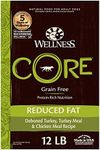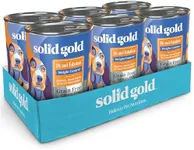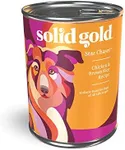Buying Guide for the Best Low Fat Dog Foods
Choosing the right low-fat dog food for your furry friend is crucial for their health and well-being. Low-fat dog foods are typically recommended for dogs with specific health issues such as pancreatitis, obesity, or digestive problems. When selecting a low-fat dog food, it's important to consider several key specifications to ensure that the food meets your dog's nutritional needs while also being palatable and enjoyable for them. Here are some key specs to consider and how to navigate them to find the best fit for your dog.Fat ContentFat content is the primary specification to look at when choosing low-fat dog food. This spec indicates the percentage of fat in the food. Low-fat dog foods typically have less than 10% fat on a dry matter basis. For dogs with health issues like pancreatitis, a fat content of 5-8% may be recommended. For weight management, a slightly higher fat content might be acceptable. Always consult your vet to determine the appropriate fat level for your dog's specific needs.
Protein ContentProtein content is important because it helps maintain muscle mass and overall health. In low-fat dog foods, protein levels can vary, but they should generally be high enough to support your dog's needs. Look for foods with at least 18-25% protein on a dry matter basis. Active or working dogs may require higher protein levels, while less active dogs may do well with moderate protein content. Ensure the protein source is high-quality, such as chicken, fish, or lamb.
Fiber ContentFiber content helps with digestion and can aid in weight management by making your dog feel fuller for longer. Low-fat dog foods often have higher fiber content, typically ranging from 5-12%. If your dog has digestive issues or needs to lose weight, higher fiber content can be beneficial. However, too much fiber can cause digestive upset, so it's important to find a balance that works for your dog.
Caloric DensityCaloric density refers to the number of calories per serving. Low-fat dog foods often have lower caloric density to help with weight management. Check the calorie content per cup or per kilogram to ensure it aligns with your dog's energy needs. Active dogs may require more calories, while less active or overweight dogs may need fewer calories. Adjust portion sizes accordingly to maintain a healthy weight.
Ingredients QualityThe quality of ingredients is crucial for your dog's overall health. Look for dog foods with high-quality, natural ingredients and avoid those with artificial additives, fillers, or by-products. Whole foods like real meat, vegetables, and grains are preferable. High-quality ingredients ensure better nutrition and can help prevent allergies and other health issues.
PalatabilityPalatability refers to how appealing the food is to your dog. Even the healthiest food won't be beneficial if your dog refuses to eat it. Look for foods with flavors and textures that your dog enjoys. You may need to try a few different options to find one that your dog likes. Wet foods or foods with added flavor enhancers can sometimes be more appealing to picky eaters.
Brand ReputationBrand reputation can give you an idea of the quality and reliability of the dog food. Choose brands that are well-known and have positive reviews from other pet owners. Brands that conduct regular quality checks and have a history of producing high-quality pet foods are generally more trustworthy. Research the brand's history and look for any recalls or issues that might raise concerns.




















